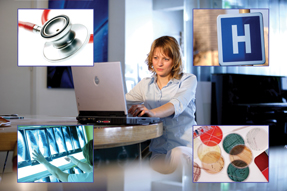Wisconsin clinic's patients save time by ‘rooming’ themselves
An outpatient family practice clinic tries to reduce wait times by letting patients direct themselves to open exam rooms. As a result, wait times fell by half and patient satisfaction rose to its highest levels in 11 months.
Where: UW Health Monona, an outpatient family practice clinic in Monona, Wisc., associated with the University of Wisconsin School of Medicine and Public Health.
The issue: Reducing patient wait times.
Background
The Monona clinic was slated to move into a new location, so the physicians had the chance to decide on the ideal layout for their practice. The existing clinic faced the common struggle of getting patients in to see their doctors in the most efficient way.
“We were trying to improve patient satisfaction as far as waits and delays,” said Byron Marquez, DO. “Also, we just wanted to see if we could decrease wait times, especially those initial wait times from when the patient checks in to the time when they actually see the doctor.”
After looking around at other clinic models around the country, Dr. Marquez decided to try out one used by Virginia Mason Medical Center in Seattle, Wash. Called “no-wait rooming,” the system involves patients directing themselves to open exam rooms, instead of waiting in a reception area to be taken to one.
How it works
“The patient checks in with our reception staff and then they are given directions to go directly to the room that they are assigned,” explained Dr. Marquez. Patients are provided with maps to help them find their assigned room and a card to mark the door of the exam room as occupied after they enter. If all the exam rooms are occupied, patients wait in the reception area and are given a card when a spot becomes available.
Clinical staff members are alerted to the patient's arrival in an exam room, both by the card on the door and a computer notification from the reception desk. “The clinical staff typically is waiting for them, so [the patients] quickly can see the clinical staff and be given directions about changing and things like that,” Dr. Marquez said. If patients' heights or weights need to be taken, a staff member will take them back out of the room for the measurements, but otherwise, they'll wait in the exam room until the physician arrives.
Results
Since implementation of the new system, waiting time in reception and exam rooms has decreased by 50%. “We surveyed the first 100 or more patients and well over 90% said this is much improved. They felt like their wait times were much less, not only initially, but also waiting to see me, once they were in the room,” said Dr. Marquez. Those initial reports were confirmed by improvements in the clinic's scores on Press Ganey surveys for patient satisfaction with waits and delays, which rose to their highest levels in 11 months.
Physicians—first just Dr. Marquez and then his partners who implemented the system—were also more satisfied with wait times. “I didn't have to wait for patients to get ready. They were ready more often either before or at their regular appointment time, so it was a lot easier for me to move through my day,” he said.
With the patients bringing themselves into view of the clinical staff, they tend to attract more immediate attention. “Overall, this has heightened staff sensitivity to patient needs and staff vigilance to be sure patient needs are addressed quickly,” said Dr. Marquez.
He has observed other potential benefits to the system as well. “A lot of folks say this is a lot more private too. I don't have somebody come out calling my name in a room full of 20 people. Also, we haven't really measured this, but in terms of infection control in flu season, you're not sitting out there with all these other people who are sick and coughing.”
Challenges
As with any change in procedure, they were some kinks to work out during implementation. “Be sure they've got it flowed out how to keep track of the patient,” Dr. Marquez advises anyone hoping to copy the system. “Don't lose sight of them during their visit.”
Overflow situations (in which patients are waiting in reception) and trips to the lab or X-ray are potential spots for losing patients, he warned. “There still needed to be vigilance on the part of the staff to watch to be sure patients were set.”
Patients can also lose themselves, before they come under the vigilant eye of the Monona clinical staff. “Sometimes they'll come in and because of the way our clinic's laid out, the patient's wondering where to go,” said Dr. Marquez.
Next steps
The clinic's new location, which is scheduled to open in late 2010, should help with that final challenge. “We've designed the clinic specifically to make it a lot easier for patients to have a clear line of sight as to where they need to go, so not so many twists and turns. We set up some other signaling systems for clinical staff to know where patients are and who needs to be attended to next,” Dr. Marquez said. In addition, the practice will add tools to measure height, weight, and visual acuity in each exam room so vital signs can be obtained without the patient needing to leave the room.
The clinic will also have one other modification, thanks to the success of no-wait rooming, he said. “Our waiting room will be much smaller than it would have been otherwise, because we don't plan to use it much.”
Words of wisdom
“One thing we could have done better was involving a patient or two to help us plan this. I think they would have valuable insight as well,” said Dr. Marquez.





